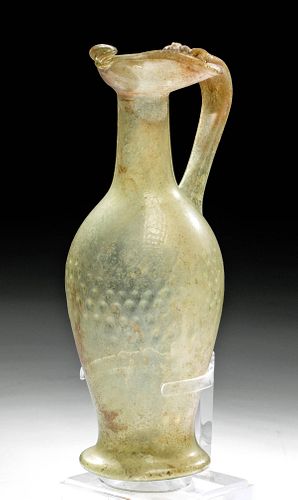Roman Glass Trefoil Jug w/ Honeycomb Pattern
Lot 43
About Seller
Artemis Gallery
686 S Taylor Ave, Ste 106
Louisville, CO 80027
United States
Selling antiquities, ancient and ethnographic art online since 1993, Artemis Gallery specializes in Classical Antiquities (Egyptian, Greek, Roman, Near Eastern), Asian, Pre-Columbian, African / Tribal / Oceanographic art. Our extensive inventory includes pottery, stone, metal, wood, glass and textil...Read more
Categories
Estimate:
$1,800 - $2,500
Absentee vs Live bid
Two ways to bid:
- Leave a max absentee bid and the platform will bid on your behalf up to your maximum bid during the live auction.
- Bid live during the auction and your bids will be submitted real-time to the auctioneer.
Bid Increments
| Price | Bid Increment |
|---|---|
| $0 | $25 |
| $300 | $50 |
| $1,000 | $100 |
| $2,000 | $250 |
| $5,000 | $500 |
| $10,000 | $1,000 |
| $20,000 | $2,500 |
| $50,000 | $5,000 |
| $100,000 | $10,000 |
| $200,000 | $20,000 |
About Auction
By Artemis Gallery
Jul 16, 2020
Set Reminder
2020-07-16 10:00:00
2020-07-16 10:00:00
America/New_York
Bidsquare
Bidsquare : Ancient / Ethnographic Art Through The Ages
https://www.bidsquare.com/auctions/artemis-gallery/ancient-ethnographic-art-through-the-ages-5334
Ancient art from Egypt, Greece, Italy and the Near East, as well as Asian, Fossils, Pre-Columbian, Native American, African / Tribal / Oceanic, Spanish Colonial, Russian Icons, Fine art, much more! Artemis Gallery info@artemisgallery.com
Ancient art from Egypt, Greece, Italy and the Near East, as well as Asian, Fossils, Pre-Columbian, Native American, African / Tribal / Oceanic, Spanish Colonial, Russian Icons, Fine art, much more! Artemis Gallery info@artemisgallery.com
- Lot Description
Roman, late Imperial Period, ca. late 3rd to 4th century CE. A delicate pouring jug formed from translucent glass of a pale yellow-green hue. The vessel features a concave base with a rough pontil scar, an inverted piriform body atop a flared foot, and a tapered neck. Surrounding the body are dozens of shallow impressions arranged in a honeycomb pattern formed during the formative process using a pattern-laden tool. A pinched, trefoil-style pouring spout with an out-folded lip surmounts the neck, and a hollow, tubular trail of similarly colored glass is pulled between the rim and shoulder to form the handle. Faint areas of silvery and rainbow-hued iridescence have formed across the vessel and elegantly accentuate its gentle spring green hues. Size: 2.625" W x 6.875" H (6.7 cm x 17.5 cm); 8.2" H (20.8 cm) on included custom stand.
For a stylistically similar example with applied glass trails around the neck, please see The Metropolitan Museum, accession number 81.10.182.
For another stylistically similar example resting on an applied foot, please see "Solid Liquid: Greek, Roman, Byzantine and Islamic Glass." Fortuna Fine Arts, Ltd., New York, 1999, p. 97, fig. 180.
Provenance: private East Coast, USA collection, acquired in 2015; ex-Arte Primitivo Gallery, New York, New York, USA; ex-Elinor Katz collection, purchased in the 1970s from Barakat Antiquities, Jerusalem, Israel
All items legal to buy/sell under U.S. Statute covering cultural patrimony Code 2600, CHAPTER 14, and are guaranteed to be as described or your money back.
A Certificate of Authenticity will accompany all winning bids.
We ship worldwide and handle all shipping in-house for your convenience.
#154202Petite area of loss to base of handle, with small chips and a few stable fissures along break lines. Minor abrasions to base, body, handle, and spout, with micro-bubbling within glass matrix, and light encrustations and weathering film. Pontil mark on underside of base. A pontil scar or mark indicates that a vessel was free-blown, while the absence of such a mark suggests that the work was either mold-blown or that the mark was intentionally smoothed away or wore away over time. Nice earthen deposits as well as light silver and rainbow iridescence throughout.Condition
- Shipping Info
-
All shipping is handled in-house for your convenience. Your invoice from Artemis Gallery will include shipping calculation instructions. If in doubt, please inquire BEFORE bidding for estimated shipping costs for individual items.
-
- Buyer's Premium



 EUR
EUR CAD
CAD AUD
AUD GBP
GBP MXN
MXN HKD
HKD CNY
CNY MYR
MYR SEK
SEK SGD
SGD CHF
CHF THB
THB














